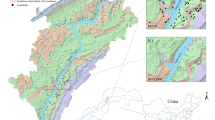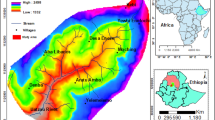Abstract
The authors have evaluated the effect of spatial resolution on the accuracy of landslide susceptibility mapping. For this purpose, landslide locations were identified from the interpretation of aerial photographs and field surveys in the Boun region of Korea. Topography, soil, forest, geological, lineament and landuse data were collected, processed, and constructed into a spatial database using GIS and remote sensing data. The 15 factors that influenced landslide occurrence were extracted and calculated from the spatial database at 5, 10, 30, 100 and 200 m spatial resolution. Hazardous landslide areas were analyzed and mapped using the landslide-occurrence factors by employing a probability models frequency ratio for the five spatial resolutions. The results of the analysis were verified using the landslide location data and area under success rate curve. The spatial resolutions of 5, 10 and 30 m showed similar results (the normalized area values 0.97, 1.00 and 0.92, respectively), but the 100 and 200 m spatial resolutions showed less well-verified data (the normalized area values 0.48, and 0.00, respectively). Because the scale of the input data was 1∶5,000–1∶50,000, the 5, 10 and 30 m spatial resolutions had a similar accuracy, but the 100 and 200 m spatial resolutions had a lower accuracy. From this, we conclude that spatial resolution has an effect on the accuracy of landslide susceptibility, as it is dependent on the input map. At least, less than 30 m resolution is need for landslide analysis in Korea where most of map scale is in the range 1∶5,000–1∶50,000.
Similar content being viewed by others
References
Bonham-Carter, G.F., 1994, Geographic Information Systems for geoscientists, modeling with GIS. Pergamon Press, Oxford, 398p.
Chung, C.F. and Fabbri, A.G., 1999, Probabilistic prediction models for landslide hazard mapping. Photogrammetric Engineering & Remote Sensing, 65, 1389–1399.
Clerici, A., Perego, S., Tellini, C. and Vescovi, P., 2002, A procedure for landslide susceptibility zonation by the conditional analysis method. Geomorphology, 48, 349–364.
Dai, F.C., Lee, C.F., Li, J. and Xu, Z.W., 2001, Assessment of landslide susceptibility on the natural terrain of Lantau Island, Hong Kong. Environmental Geology, 40, 381–391.
Donati, L. and Turrini, M.C., 2002, An objective method to rank the importance of the factors predisposing to landslides with the GIS methodology: application to an area of the Apennines (Valnerina; Perugia, Italy). Engineering Geology, 63, 277–289.
Guzzetti, F., Carrarr, A., Cardinali, M. and Reichenbach, P., 1999, Landslide hazard evaluation: a review of current techniques and their application in a multi-scale study, Central Italy. Geomorphology, 31, 181–216.
Larsen, M. and Torres-Sanchez, A., 1998, The frequency and distribution of recent landslides in three montane tropical regions of Puerto Rico. Geomorphology, 24, 309–331.
Lee, S. and Choi, U., 2003, Development of GIS-based geological hazard information system and its application for landslide analysis in Korea. Geosciences Journal, 7, 243–252.
Lee, S and Min, K., 2001, Statistical analysis of landslide susceptibility at Yongin, Korea. Environmental Geology, 40, 1095–1113.
Lee, S., Choi, J. and Min K., 2002a, Landslide susceptibility analysis and verification using the Bayesian probability model. Environmental Geology, 43, 120–131.
Lee, S., Chwae, U. and Min K., 2002b. Landslide susceptibility mapping by correlation between topography and geological structure: the Janghung area, Korea. Geomorphology, 46, 149–162.
Lee, S., Ryu J., Lee, M. and Won, J., 2003a, Landslide susceptibility analysis using artificial neural network at Boun, Korea. Environmental Geology, 44, 820–833.
Lee, S., Ryu, J., Min, K. and Won, J., 2003b, Landslide susceptibility analysis using GIS and artificial neural network. Earth Surface Processes and Landforms, 28, 1361–1376.
Lee, S., Ryu, J., Won, J. and Park, H., 2003c. Determination and application of the weights for landslide susceptibility mapping using an artificial neural network. Engineering Geology, 71, 289–302.
Mandy, L.G., Andrew, M.W., Richard, A. and Stephan, G.C., 2001, Assessing landslide potential using GIS, soil wetness modeling and topographic attributes, Payette River, Idaho. Geomorphology, 37, 149–165.
Randall, W.J., Edwin, L.H. and John, A.M., 2000, A method for producing digital probabilistic seismic landslide hazard maps. Engineering Geology, 58, 271–289.
Rautelai, P. and Lakheraza, R.C., 2000, Landslide risk analysis between Giri and Tons Rivers in Himachal Himalaya (India). International Journal of Applied Earth Observation and Geoinformation, 2, 153–160.
Refice, A. and Capolongo D., 2002, Probabilistic modeling of uncertainties in earthquake-induced landslide hazard assessment. Computers & Geosciences, 28, 735–749.
Turrini, M.C. and Visintainer, P., 1998, Proposal of a method to define areas of landslide hazard and application to an area of the Dolomites, Italy. Engineering Geology, 50, 255–265.
Author information
Authors and Affiliations
Corresponding author
Rights and permissions
About this article
Cite this article
Lee, S., Choi, J. & Woo, I. The effect of spatial resolution on the accuracy of landslide susceptibility mapping: a case study in Boun, Korea. Geosci J 8, 51–60 (2004). https://doi.org/10.1007/BF02910278
Received:
Accepted:
Issue Date:
DOI: https://doi.org/10.1007/BF02910278




